

Lessons - The Genocide Teaching Project - Center for Human Rights & Humanitarian Law - American University Washington College of Law. As part of its commitment to raise awareness about genocide and to end the ongoing violence currently taking place in Sudan, the Center continues to support the Genocide Teaching Project, originally developed by former WCL students Sarah Hymowitz (Marshall-Brennan Alumna) and Amelia Parker.
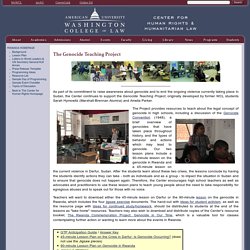
Rwanda genocide: 100 days of slaughter. Image copyright AFP In just 100 days in 1994, some 800,000 people were slaughtered in Rwanda by ethnic Hutu extremists.

They were targeting members of the minority Tutsi community, as well as their political opponents, irrespective of their ethnic origin. Why did the Hutu militias want to kill the Tutsis? About 85% of Rwandans are Hutus but the Tutsi minority has long dominated the country. In 1959, the Hutus overthrew the Tutsi monarchy and tens of thousands of Tutsis fled to neighbouring countries, including Uganda. On the night of 6 April 1994 a plane carrying then President Juvenal Habyarimana, and his counterpart Cyprien Ntaryamira of Burundi - both Hutus - was shot down, killing everyone on board.
Rwanda's mystery that won't go away How was the genocide carried out? With meticulous organisation. Did anyone try to stop it? The UN and Belgium had forces in Rwanda but the UN mission was not given a mandate to stop the killing. A good man in Rwanda Why was it so vicious? How did it end? Short Story Monday: Color Me Brown. I’ve finally gotten back into reading short stories online!

I wandered through The New Yorker‘s free archives this weekend, and read four stories by people of color for the Color Me Brown Challenge. They were all by authors that I’d heard good things about, but not read any of their work before. I’ve linked the titles through to the stories so you can read them too. :) As always, I review short stories on Monday to participate in John Mutford’s Short Story Monday event. “War Dances” by Sherman Alexie “War Dances” was definitely my favourite of the bunch, and I now have Alexie’s first novel on hold at my library. It manages to be funny and profound and tell a story and meditate on characters and everything a good story should do. And then I saw him, another Native man, leaning against a wall near the gift shop. Most of it takes place around hospitals and illnesses, both the narrator’s own (he’s a married man with two younger kids) and those of his father.
Like this: My Parents’ Bedroom. I’m nine years and seven months old.
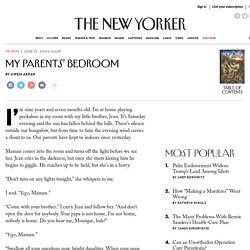
I’m at home playing peekaboo in my room with my little brother, Jean. It’s Saturday evening and the sun has fallen behind the hills. There’s silence outside our bungalow, but from time to time the evening wind carries a shout to us. Our parents have kept us indoors since yesterday. Maman comes into the room and turns off the light before we see her. Rwanda genocide anniversary: A story of love and death. Rwanda genocide Tensions between Hutu and Tutsi ethnic groups started with the Belgian colonisation in 1922.
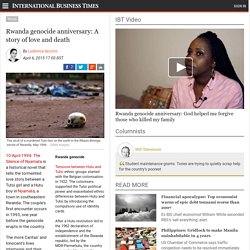
The colonisers supported the Tutsi political power and exacerbated ethnic differences between Hutu and Tutsi by introducing the compulsory use of identity cards. 10 April 1994: The Silence of Nyamata is a historical novel that tells the tormented love story between a Tutsi girl and a Hutu boy in Nyamata, a town in southeastern Rwanda. The couple's first encounter occurs in 1993, one year before the genocide erupts in the country. The more Caritas' and Innocent's lives intertwine and their love grows, the more the genocide threatens their future and that of their families.
It is estimated that between 800,000 and 1m people, including women and children, were killed in the three months from 6 April to 15 July 1994. The story of Patricia and Aloys, a survivor and perpetrator of the Rwandan genocide. After nearly 20 years, deep-rooted trauma from the Rwandan genocide still haunts many.
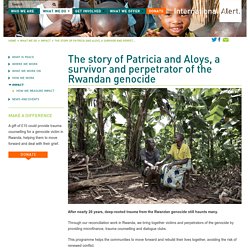
Through our reconciliation work in Rwanda, we bring together victims and perpetrators of the genocide by providing microfinance, trauma counselling and dialogue clubs. This programme helps the communities to move forward and rebuild their lives together, avoiding the risk of renewed conflict. McGinn,%20Brynn%20 %20unit. One Million Bones - Genocide Resources. Here, educators will find links to genocide curricula already in existence.
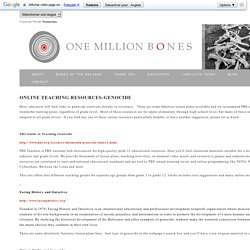
There are some fabulous lesson plans available and we recommend PBS as a wonderful starting point, regardless of grade level. Most of these resources are for upper elementary through high school level, but many of these ideas can be adapted to all grade levels. If you find any one of these online resources particularly helpful, or have another suggestion, please let us know.
PBS Guide to Teaching Genocide PBS Teachers is PBS' national web destination for high-quality preK-12 educational resources. This site offers four different teaching guides for separate age groups from grade 3 to grade 12. Facing History and Ourselves There are some absolutely fantastic lesson plans here.